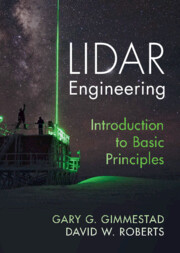Book contents
- Lidar Engineering
- Lidar Engineering
- Copyright page
- Dedication
- Contents
- Preface
- Glossary
- List of Abbreviations
- 1 Introduction
- 2 The Basic Lidar Models
- 3 The Molecular Atmosphere
- 4 Particles in the Atmosphere
- 5 Lidar Transmitters
- 6 Lidar Receivers and the Geometrical Function
- 7 Optomechanics
- 8 Optical Detection
- 9 Data Systems
- 10 Lidar Data Analysis
- 11 Applications
- Appendix A The Klett Retrieval
- Index
- References
5 - Lidar Transmitters
Published online by Cambridge University Press: 16 February 2023
- Lidar Engineering
- Lidar Engineering
- Copyright page
- Dedication
- Contents
- Preface
- Glossary
- List of Abbreviations
- 1 Introduction
- 2 The Basic Lidar Models
- 3 The Molecular Atmosphere
- 4 Particles in the Atmosphere
- 5 Lidar Transmitters
- 6 Lidar Receivers and the Geometrical Function
- 7 Optomechanics
- 8 Optical Detection
- 9 Data Systems
- 10 Lidar Data Analysis
- 11 Applications
- Appendix A The Klett Retrieval
- Index
- References
Summary
The three most common lidar transmitter-receiver configurations are illustrated, along with the basic transmitter components. The components are described sequentially, starting with the laser, with a table of the most important laser characteristics for lidar systems. Lidar beam expanders are described. Lasers are then discussed in terms of their basic requirements (an active medium, a population inversion, and optical feedback), and the properties of laser light (monochromaticity, directionality, and often polarization). Beam parameters and beam quality are then described starting with the Gaussian beam model. Measures of laser beam quality include the beam propagation ratio, spectral purity, and polarization purity. Methods for changing the wavelength are discussed, including stimulated Raman scattering, harmonic generators, and optical parametric oscillators. Laser safety, eye safety standards in terms of maximum permissible exposure, and laser classes are then covered, and the transmitter of an eye safe elastic backscatter lidar is described as an example, with an illustration and a table of its parameters.
Keywords
Information
- Type
- Chapter
- Information
- Lidar EngineeringIntroduction to Basic Principles, pp. 113 - 142Publisher: Cambridge University PressPrint publication year: 2023
